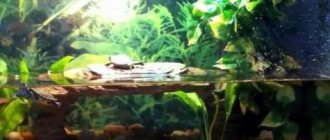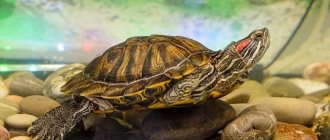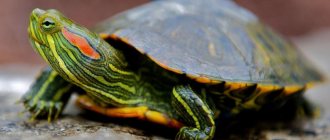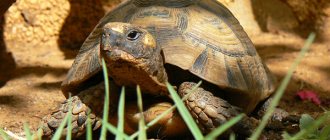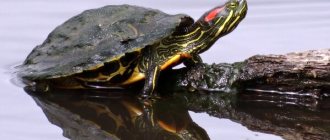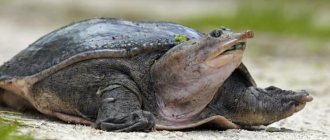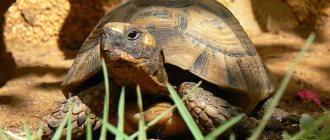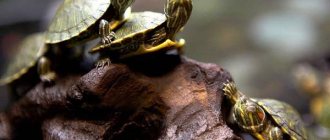This type of turtle is the most popular among buyers of exotic animals. This is explained by its high survival rate in artificial habitats.
These turtles have two red stripes on the sides of their heads, making them easy to recognize among other turtles.
They live both in water and on land, this should be taken into account when keeping a red-eared turtle at home.
Content Features
Caring for red-eared turtles is carried out at home using special equipment. Before purchasing, make sure you can create an optimal living environment. An Aquaterrarium with a volume of up to 100-200 liters is suitable.
The water must be changed no later than once a month; it must be warm (up to 28 degrees) and clean. Before pouring water, it must be left to stand for 5 days. Purchasing a filter will simplify the cleaning process.
The turtle needs to go to land in order to warm up and rest. Build an island with soil and equip it with an incandescent lamp to produce heat. In this case, there is no need to install an additional water heater.
This species of individuals is very mobile and therefore should not be underestimated. The height of the walls of the aquaterrarium must be at least 30 cm, otherwise the turtle may jump out of there, crawl into a hard-to-reach place and die from exhaustion.
Also, proximity to other animals or young animals may be unsafe. A predatory hungry turtle may start hunting.
Note!
- Indian snakes: sacred, poisonous, most common and dangerous types of Indian snakes and their names (130 photos)
Small snakes - an overview of popular and rare species, habitats, food and names of snakes (115 photos)
Snake bites - the most dangerous and poisonous snakes and the consequences of their bite (110 photos and videos)
What does a turtle look like without a shell: description, features and interesting facts
There are some myths that people know since childhood:
- Since childhood, it is commonly believed that turtles are very smart and wise, but this is not so. For many centuries they have not gained any wisdom. True, reptiles can sense the mood of their owner and even respond to it.
- Many people know that turtles are slow and this is true when it comes to land animals. They are not able to move quickly, and their speed is on average 1 km/h. In water, such animals will be 30 times faster than on land.
- Many people think that animals cannot be trained. Of course, reptiles are not dogs, but if the owner talks to the pet often, it will nod its head and may wave its paws. In addition, the animal can be taught to play with a ball. You can also teach her to distinguish sounds that will be responsible for feeding or other procedures.
As has already been said, a turtle without a shell lived only at the beginning of its evolution, and the animal grew to us with it. Moreover, without it they cannot exist today. But there are other interesting facts:
- The shell only visually appears to be a solid whole; in fact, it is made up of 50 different parts.
- The cervical vertebra of a reptile is made up of 8 parts, due to which, when the head is pulled into the shell, the animal can fold its neck three times and in the shell itself it lies in the shape of the letter “S”.
- Turtles are considered to be the very first to go to the moon; this happened in the USSR in 1968. The animals were not only alive after the flight, but also healthy. Some individuals lost a few grams.
- Most turtle breeds are aggressive predators.
- Animals do not have vocal cords, but they can make different sounds.
- Certain breeds of reptiles can breathe through their butts. The cloaca can provide oxygen to an animal if it remains under water for a long time.
News and Society May 6, 2016
Everyone who went to school was required to attend biology classes. However, if you ask a hundred people what the inside of a turtle looks like, 99 of them will not be able to answer.
We suggest you read: Turtles at home, how long they can live: sea turtle, land turtle and Central Asian turtle
There is an opinion that any Tortilla can safely leave her leathery house and go for a walk. Let's see if this is true.
What does a turtle look like without a shell and what does it serve as a home or clothing? Let's try to answer these questions.
Caring for a red-eared slider
They, like other predators, feed mainly on protein foods, for example, small worms, bloodworms or crustaceans are suitable for babies. But stronger turtles can eat cockroaches, snails, crickets, and earthworms.
Beef liver, liver or chicken hearts are also suitable. The fish should be cut into small ribbons and scalded with boiling water. Under no circumstances should you give minced meat, sausages, sausage, cheese or bread.
In addition to meat, it is necessary to add lettuce, cabbage or seaweed to the diet to avoid the development of diseases.
At a young age, the red-eared turtle needs to be fed daily; adults feed once every 2-3 days. Turtles are very active during the day, so feeding should be done at the same time.
You should also take care of the claws and trim them with clippers from time to time. Be careful not to injure your paws.
If it is impossible to install ultraviolet lamps, it is advisable to place the turtle in the sun near a water tank, avoiding direct rays.
Under ideal conditions, the presence of ultraviolet lamps and compliance with the temperature regime, the vitamin complexes included in the feed do not need to be used.
Distinctive features of the red-eared slider
- home
- Keeping red-eared turtles
- Distinctive features of the red ear...
| Date: June 3, 2018 | Category: Keeping red-eared turtles | Comments: No comments |
A distinctive feature of the American individual is its red stripe. The juvenile has a brighter stripe than the adult red-eared slider. The shell is smooth and round in shape. The color of the turtle's shell is green with black and yellow lines. The older the freshwater individual, the darker it is.
Pond slider
The length of the shell is not an indicator of age, since the red-eared reptile grows quite quickly when kept at home. The achieved sizes depend on environmental conditions, quality of care and health of the pet. The temperature of the water in the terrarium depends on the age and time of year. The temperature should be highest in summer and autumn. For young representatives, the water should always be warm.
For small representatives, the basis of nutrition is a completely plant-based diet. Upon reaching a size of 10 centimeters, animal food is proportionally added to the diet. In old age, the diet of an individual again becomes predominantly of plant origin. Read more about what to feed your red-eared slider in a separate article.
Dimensions
The size of red-eared turtles is measured using a ruler; to determine the length, the shell is measured, its irregularities are not taken into account. Newborns are born about 3 centimeters in length. The average size of a sea turtle is 20 centimeters. The duration of growth and maximum size depends on living conditions. As practice shows, the better the living conditions, the better the individuals grow.
a red-eared slider not only grows quickly, but can also grow several centimeters more; how much will also depend on environmental conditions.
Life expectancy varies; a domestic specimen, if well maintained, will live longer than other representatives. On average - about 30 years.
Red-eared slider size
How many years a pet will live at home, and to what size a red-eared turtle will grow, depends on its breeder.
Do you need neighbors?
The reptile does not have a friendly disposition. Often turtles kept in the same container at home start fights, this behavior is especially observed in adulthood. It is recommended to keep representatives of the same species separately from each other. If it is not possible to move pets into different terrariums, the space can be divided using partitions.
Recommendations for breeding reptiles in one terrarium:
* the size of individuals must be the same; * there should not be more than one male in a group; * individuals must be of equal age.
Frogs, toads, lizards and snakes and other similar individuals are perceived by turtles exclusively as food.
How to care for a red-eared slider
A novice breeder should know how to properly care for their pet. Keeping a red-eared turtle requires high-quality regular care and proper diet. A red-eared turtle kept at home should not be disturbed frequently, especially small pets that have recently appeared in the terrarium.
New individuals need time to adapt without the risk of stressful situations. To care for reptiles, it is recommended to carry out frequent cleaning, monitoring the cleanliness of the water, bathing procedures, and the habitat must be equipped with everything necessary. This little knowledge about care and maintenance will be enough for the longevity and health of your red-eared pet .
Necessary items and tools
To ensure good life, the red-eared turtle must receive not only high-quality care, but also have all the necessary items to furnish its home.
The main list of what you need to keep a red-eared turtle:
* suitable container; * 100 Watt water heater; * filter; * incandescent lamp; * lamp; * island; * thermometer; * decorative stones.
It is not recommended to use aquarium plants, live or artificial. All flora is at risk of being eaten, and some plant species are deadly to turtles. If soil is used, it must be coarse.
Choosing and arranging housing
Domestic red-eared pets require a large terrarium or aquarium (volume of at least 150 liters). The height should be greater than the width of the adult representative’s shell, since it needs to turn over freely. For a small individual, you can use a small vessel, within 50 liters. To keep a pet, you need to pour water so that it can stand on its hind legs and stick out its muzzle.
If you plan to use wooden driftwood, then you need to keep them in boiling water for some time. All plastic products must be of high quality and non-toxic. All elements of the turtle's interior, such as the substrate, island and other decorative elements, should be washed regularly under tap water.
An island of land should be installed inside the terrarium, onto which the reptile can freely climb. Incandescent light bulbs of 40 and 60 W should be located no higher than 25 centimeters; if the location is lower, the light will disturb the reptiles by getting into their eyes.
Aquarium water
The quality of care and the main condition for keeping a turtle is the condition of the water inside the aquarium. It is important to maintain cleanliness and maintain the required temperature of the liquid. Pets spend most of their lives in an aquatic environment, therefore, it should be replaced and filtered carefully to prevent the occurrence of diseases.
Island for turtle
It is important for red-eared turtles to have free access to the shore; on a piece of land it can rest and bask; this requirement applies to all individuals.
Water for the aquarium must be settled and free of chlorine. The temperature should vary from 22 to 28 degrees. If the water drops below 20 degrees, it should be heated using a heater; for accurate measurements, you must use a thermometer.
Once a week it is important to carry out water changes , no more than 1/3 of the part. It is forbidden to replace the water completely, as the internal biological balance of the terrarium, which is favorable for life, will be disrupted.
Heater and filter
To properly keep pets at home, it is important to satisfy their natural need to bask on land. The shell should heat up to 35 degrees; for this, the individual must install a lamp. It is important to monitor the temperature on the thermometer. Do not place the heat source too close to prevent your pet from getting burned. The lamp must be hidden from splashes of water and resulting fumes. The heat source must operate throughout the entire daylight period every day.
When choosing a filter, you should take into account all the features of internal and external cleaning elements. The filter is selected taking into account the volume of the terrarium. External elements require less maintenance and are safer for the reptile, since the internal filter can be removed by a pet and damaged.
Features of handling a pet
Red-eared turtles should not be allowed on the floor. They can bite, hiss and show aggression; you should handle it carefully when picking it up; it is recommended to hold the reptile with both hands; the shell can be quite slippery. After contact with pets, hands must be washed with soap; a large number of pathogenic bacteria accumulate on the shell.
Living in their natural environment, turtles independently obtain all the vitamins and minerals necessary for health. In a home environment, the owner must independently add important elements to the feed.
Mandatory list of useful substances:
* vitamins d3, A and E; * calcium; * minerals.
All additives must be added strictly following the instructions and recommendations; any overdose is dangerous for the life of the individual.
Walks
A red-eared turtle kept at home needs walks in the summer. Thus, it becomes possible to get a dose of ultraviolet rays, eat healthy grass, and breathe fresh air. The place for a walk should be clean, away from the road, with lawn grass.
The temperature in the shade should not exceed 20 degrees, and the walking time should not exceed half an hour. When walking, there should be water in a visible, accessible place. In order not to lose your pet among the green grass, it is recommended to attach a bright mark, for example, orange, to the shell, it can be a sticker or a flag.
Care and hygiene
It is recommended to arrange water treatments for pets at least once a week. Waterfowl turtles need more frequent bathing or a bathing container in their terrarium. Water for bathing should be warm, but not more than 32 degrees, boiled if possible. The fluid level must be comfortable for standing with your head retracted.
Bathing a turtle
During the first bath, you should carefully monitor the procedure to avoid frightening the animal. If the reptile does not feel well in the water and refuses to bathe, it is recommended to limit itself to spraying the shell and skin. If the bathing container is freely accessible inside the terrarium, the liquid must be changed every day.
It is recommended to use a cloth or sponge for washing; they must be soft. The use of chemicals is prohibited. For preventive measures against fungus, methylene purchased at a pet store is used. After each contact with water, the turtle should have the opportunity to dry and warm up under an ultraviolet lamp. She cannot tolerate temperature changes in the aquarium, which increases the risk of colds.
conclusions
Before getting a yellow-bellied reptile, you need to re-read the description of the article in detail again; a red-eared turtle may die if environmental conditions do not meet its needs.
Keeping turtles requires knowledge of care information and the availability of all the necessary equipment for a comfortable habitat for the red-eared representative. To keep a reptile, it is necessary to provide the aquatic environment and land surface, the proper temperature, and also take care of the cleanliness of the home when keeping it at home.
TOP 10 mistakes when keeping red-eared turtles
Share news:
Be sure to check out these posts as well:
- Keeping and feeding the red-eared turtle The red-eared turtle belongs to the family of freshwater turtles (Emydidae). The ability of these turtles to live in low-flowing waters...
- Handling the Red-eared Slider They may be slippery with water, struggle, hiss, and have bowel movements. They have sharp claws...
- The red-eared turtle's eyes are swollen. What to do? Under natural conditions, red-eared turtles have fairly good health. But at home, not always...
The entry has tags: features of the red-eared turtle. Reprinting of any site materials without an active link is prohibited!
Character and behavior
In the photo, red-eared turtles may seem like cute and harmless creatures, but in life they are quite aggressive.
When confronted with an enemy, the turtle begins to hiss, and in a calm state it can snort and even whistle. Their shell has nerve endings, so they can feel any touch.
Depending on the situation, a turtle can change color like a chameleon, but this happens much more slowly, about 2 hours. Bright acid colors, of course, will not appear, but the overall background may change to a lighter or darker side.
These are very fast and strong predators, so don’t think that all turtles are slow. Most of the time these individuals move little, but during hunting they can reach high speeds on land and even overcome obstacles.
If turtles are not accustomed to being handled, they may bite. Be careful before feeding your red-eared slider.
Reproduction
Puberty in a marsh turtle occurs at 6-8 years. The mating season for reptiles begins in the spring and lasts from May to July. Turtles can mate both in water and on land.
After mating, after 1-2 months, the reptile is ready to lay eggs. The turtle lays its eggs on the shore of a pond. She digs a hole 10 cm deep and then lays 5 to 10 eggs there. The weight of one egg is about 8 grams.
Depending on the air temperature, the incubation period lasts 2 or 3 months. The babies dig holes not far from the laying site and go into hibernation. Wintering begins in October, when the air temperature drops significantly. In the spring, when the air warms up to 6-15 degrees, the babies come out of hibernation and begin an independent life.
Conclusion
Before purchasing a red-eared turtle, carefully read the maintenance instructions. Improper conditions can lead to the death of the animal.
It is necessary not only to know the needs and features of care, but also to have the appropriate equipment in your aquaterrarium.
Remember that in addition to the aquatic environment, you should arrange a corner of land and maintain the proper temperature. Monitor the cleanliness and condition of the water so that your red-eared pet lives in a comfortable environment.

